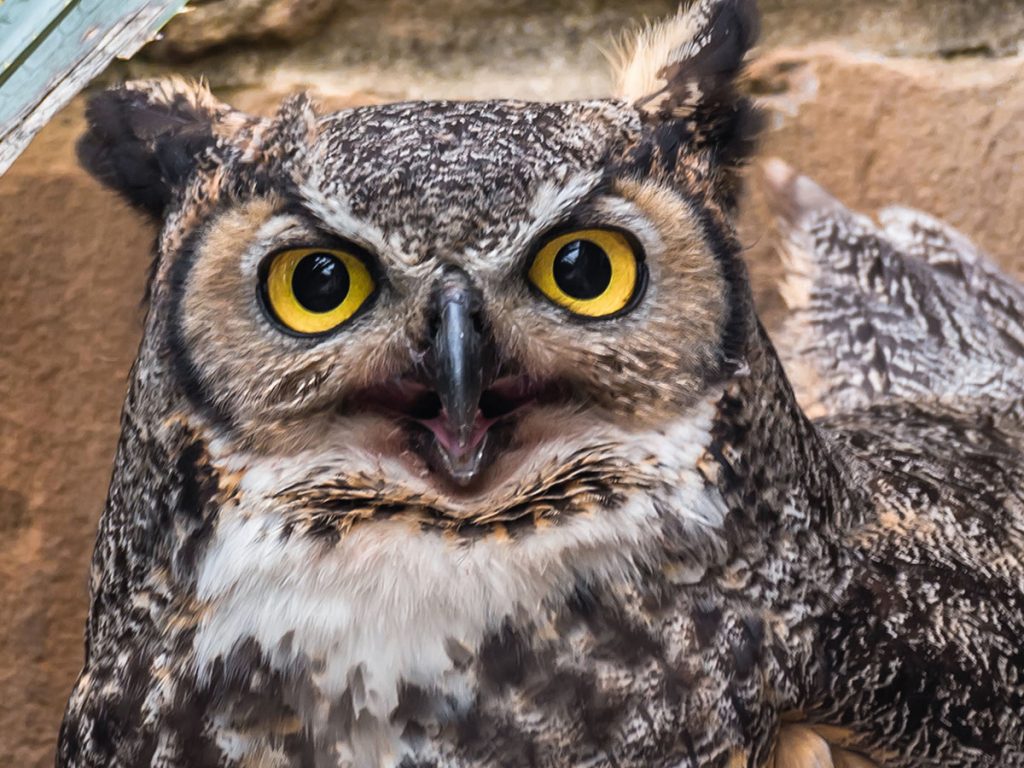PRESSROOM
Wildflower Center Launches Live Owl Nest Cam

Athena smiling PHOTO Bill J. Boyd
Austin, Texas’ much-loved Great Horned Owl ‘Athena’ featured through collaboration with Cornell Lab of Ornithology
Austin, TX– For the 14th consecutive year, the Lady Bird Johnson Wildflower Center’s beloved great horned owl, Athena, has returned to her highly visible nesting site just beyond the entrance to the Center’s gardens. Over the coming weeks, visitors, volunteers and staff alike will watch and wait to see if fluffy white owlet feathers will start to appear on the ledge of the nesting area, for all garden visitors to see.
And this year, the world can watch along live, as Athena nests live on a video stream installed through a collaboration with the Cornell Lab of Ornithology.
Link: Athena the Great Horned Owl Live Cam
Athena is well known in the Austin area because she nests in a very conspicuous place, right above the entrance to the Wildflower Center’s Courtyard. Her nest is in a raised planter, safely nestled in a corner and underneath a sotol (Dasylirion wheeleri) plant that provides some shade and shelter. When conditions are right and her eggs hatch into owlets, the nest location provides a rare opportunity to view a wild great horned owl – up close and personal – rearing her young.
“Athena is the most-photographed owl in Texas,” says Bill Boyd, a docent at the Wildflower Center who’s been meticulously following Athena since 2012. Boyd, a photographer who may be found near Athena’s nest site almost daily during her nesting season, revels in pointing her out to garden visitors and answering questions about her nesting habits. “She’s a wonder to behold, and everyone who sees her smiles.”
Thousands of people visit the Wildflower Center each spring in hopes of seeing Athena and her owlets, who, due to the nest location, are merely feet away from daily garden guests. The new live camera will include infrared technology, which will allow nighttime viewing of the mostly nocturnal owls’ behaviors, from incubating to feeding to fledging.
“Watching Athena raise owlets each year has provided us with an opportunity to more deeply connect with nature and is testament to the power of creating healthy environments,” says Lee Clippard, Executive Director of the Wildflower Center. “It has been such an amazing experience for our guests that we decided to share it with those who can’t visit in person.”
Since her first appearance in the gardens of the Wildflower Center, Athena has successfully raised owlets every season but one, when she mysteriously left the nest after about two weeks’ time. Wildlife can be unpredictable, and there is no guarantee that the famed owl will remain in the nest through egg-laying, incubation, and hatching this year. But there is reason to be hopeful.
“This particular great horned owl has been very consistent in her nesting habits over the years,” says Charles Eldermire, Project Leader for Cornell Lab’s Bird Cams. “She clearly feels safe in her chosen nest site at the Wildflower Center and has been unbothered by the high volume of visitors, so adding a camera that is tucked into the existing architecture about 20 feet away is unlikely to affect her nesting behavior. We’re excited to share her – and hopefully her owlets – with the world.”
Athena the owl has appeared each year during the start of wildflower season, incubating her eggs for around four weeks, then caring for the owlets – with the help of her mate – for up to six weeks following hatching.
“We’re excited to share this more intimate window into Athena’s life, because there’s so much more to learn about her,” said Dr. Sean Griffin, the Center’s Director of Science and Conservation. “Partnering with the Cornell Lab of Ornithology is a perfect example of how we’re finding creative ways to share what we do with a broader community.”
For more information about visiting Athena at the Lady Bird Johnson Wildflower Center, visit the website here.
Follow Athena’s nest with the Wildflower Center on Instagram here.
All of the Cornell Lab’s live cams may be accessed here.
For press inquiries, contact Scott Simons, Director of Marketing and Communications at the Wildflower Center.
About The Lady Bird Johnson Wildflower Center
The Lady Bird Johnson Wildflower Center is part of The University of Texas at Austin and welcomes more than 245,000 guests to its 284 acres of gardens, trails, and exhibitions each year, fulfilling its mission to inspire the conservation of native plants. Designated the State Botanic Garden and Arboretum by the Texas legislature in 2017, the Wildflower Center’s investments in science, education and conservation include a native seed bank, one of the most comprehensive databases of North American native plants, and a research program in collaboration with the University. Founded in 1982, the Center is the embodiment of Lady Bird Johnson’s environmental legacy. As she noted, “Our Center works for more than the lovely blossoms in our open spaces. We are concerned for all of North America’s native plants, from the smallest sprout to the tallest tree.”
About the Cornell Lab of Ornithology
The Cornell Lab of Ornithology is a membership institution dedicated to interpreting and conserving the earth’s biological diversity through research, education, and citizen science focused on birds.
